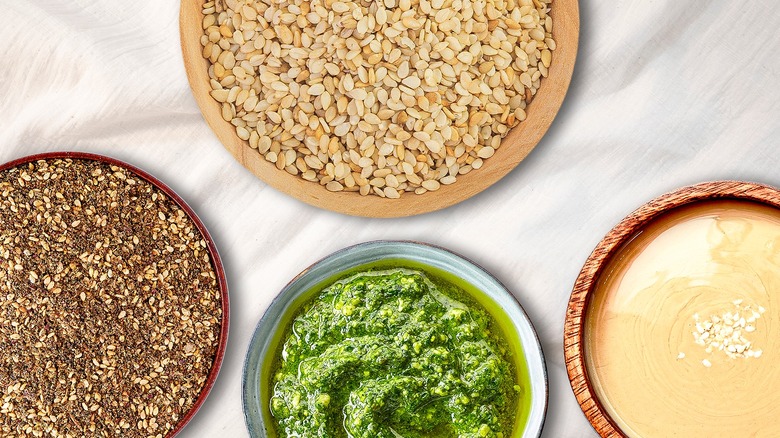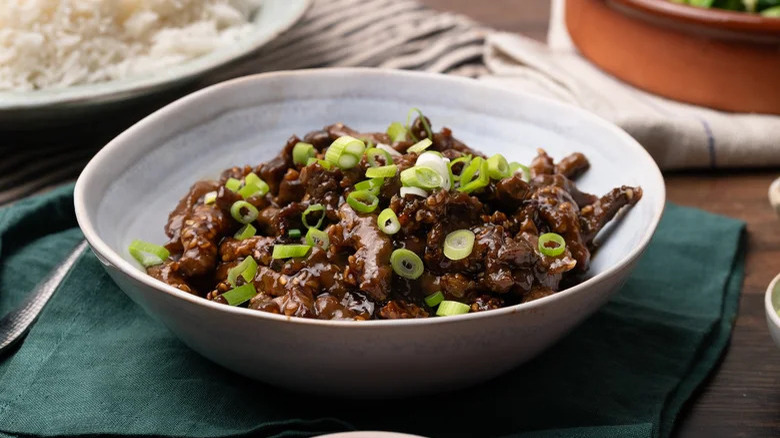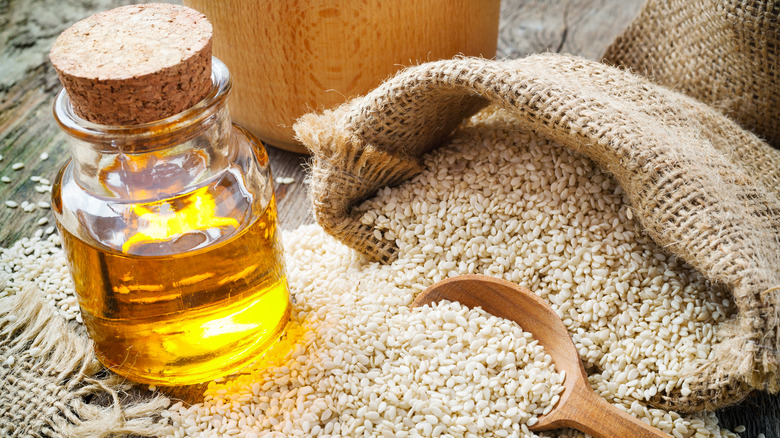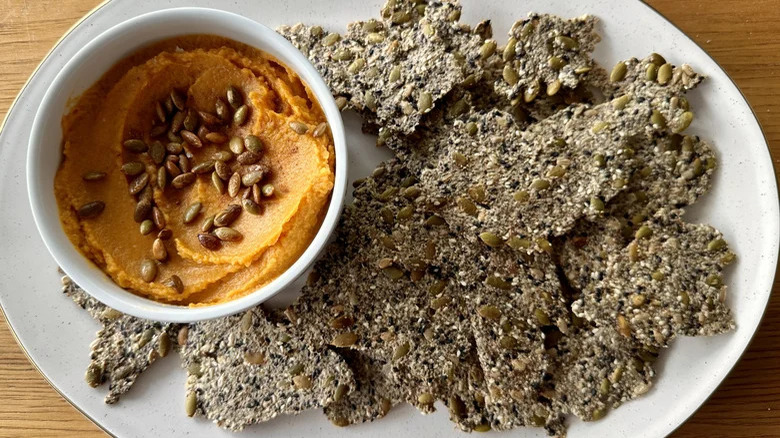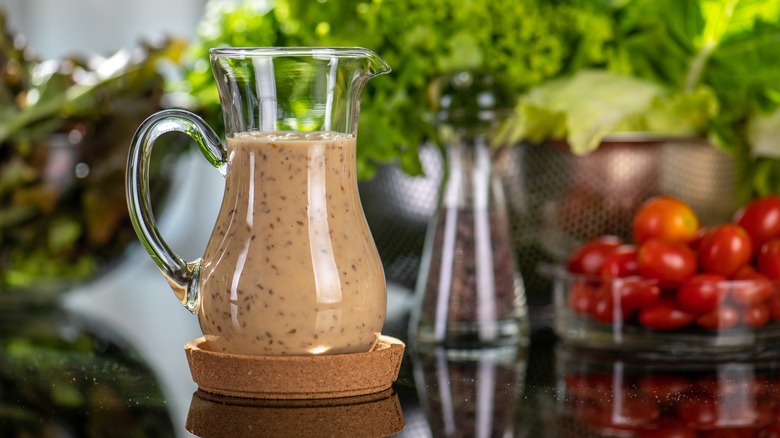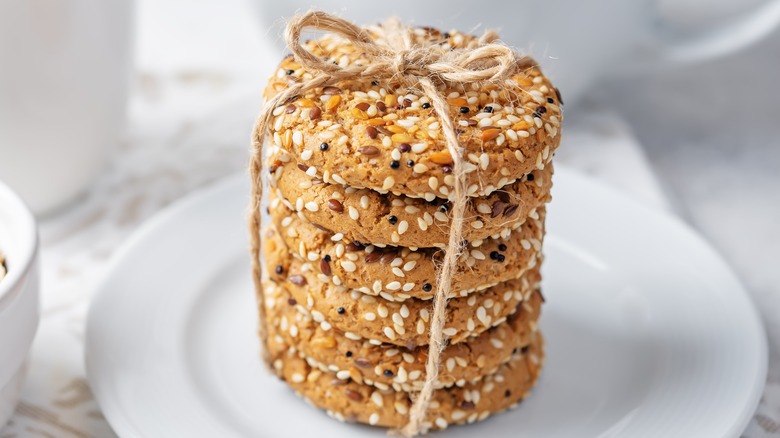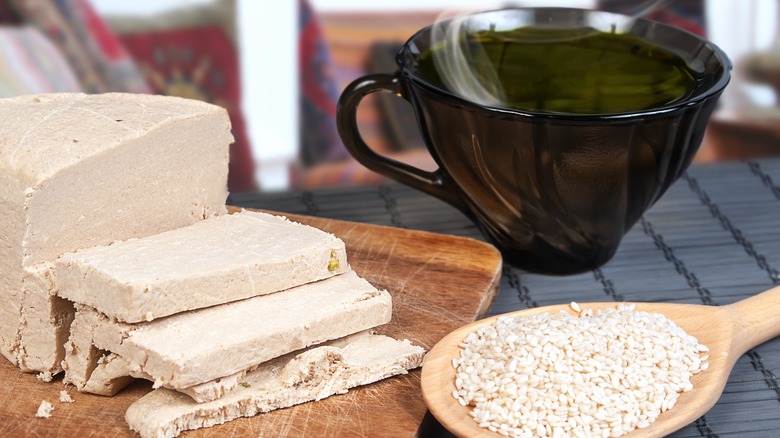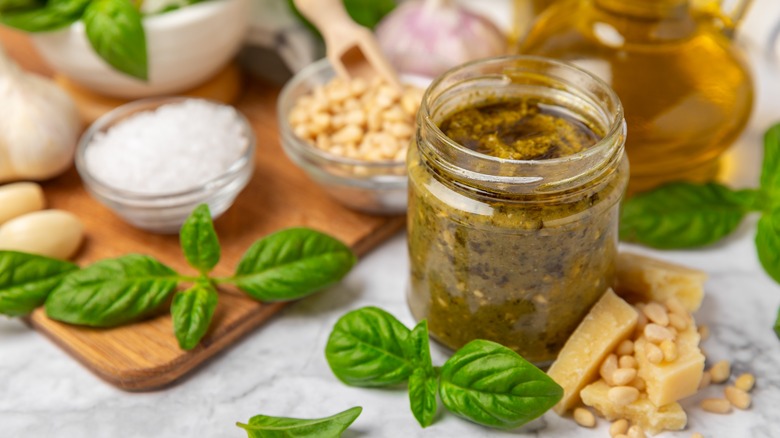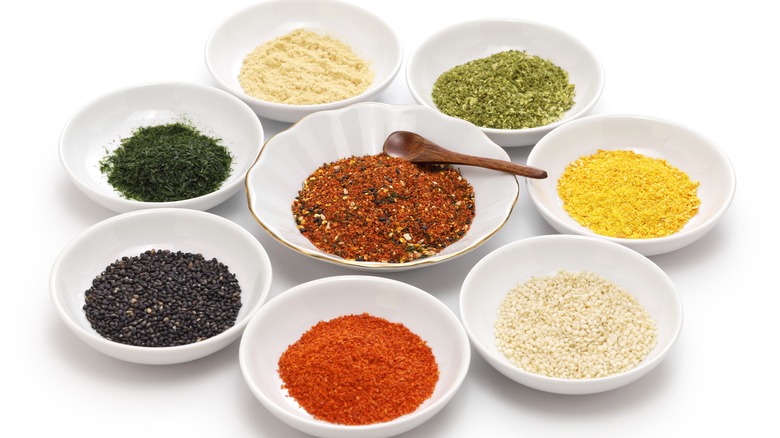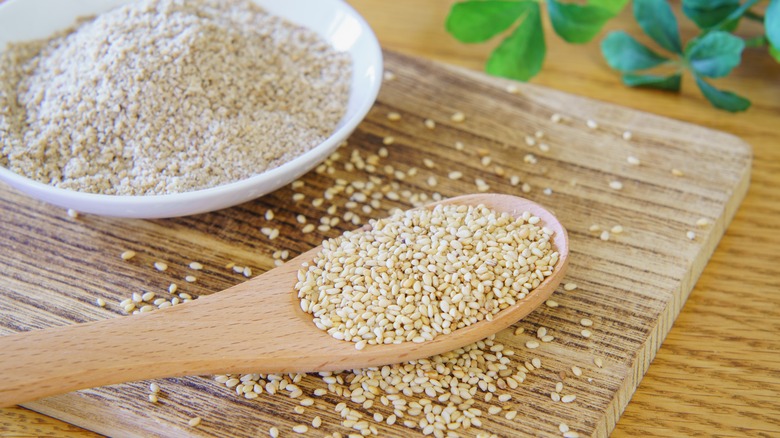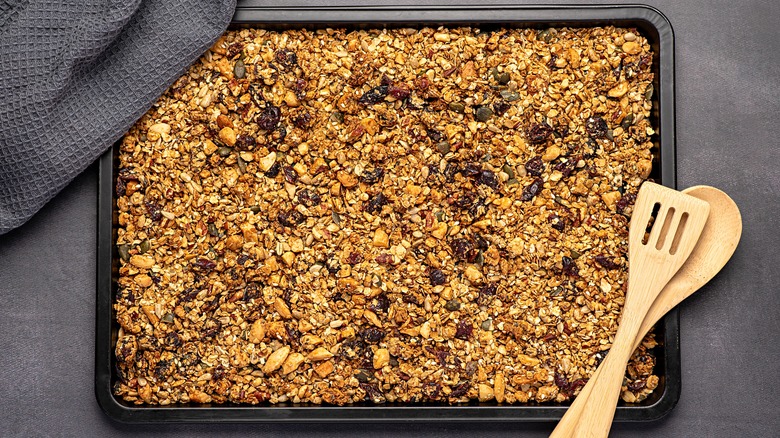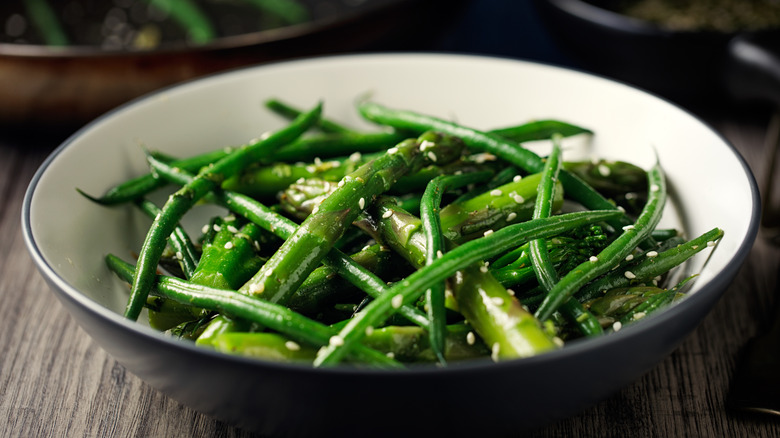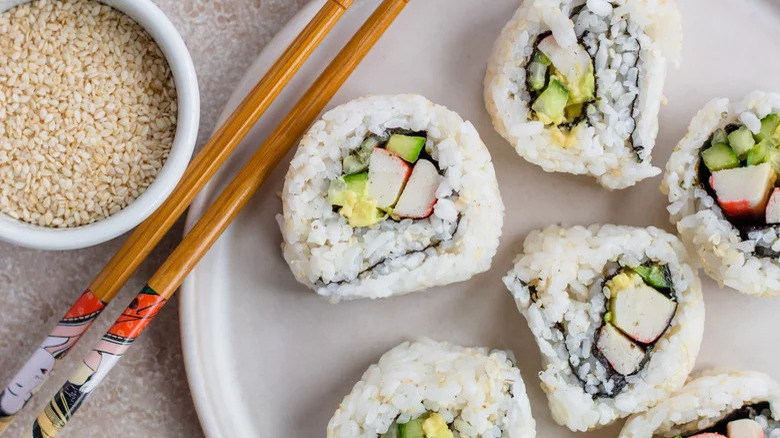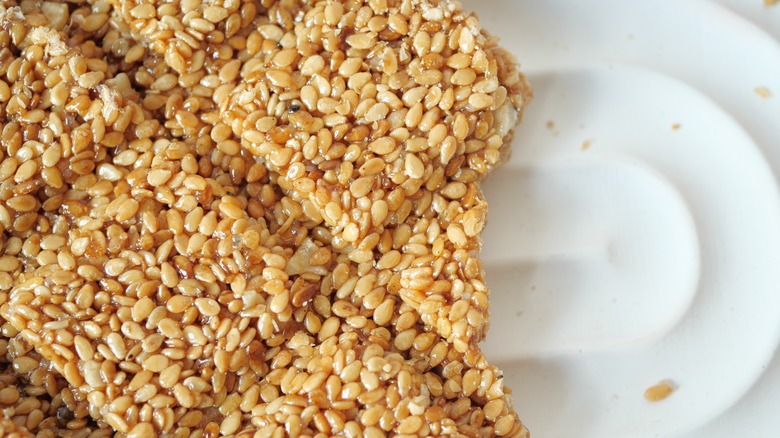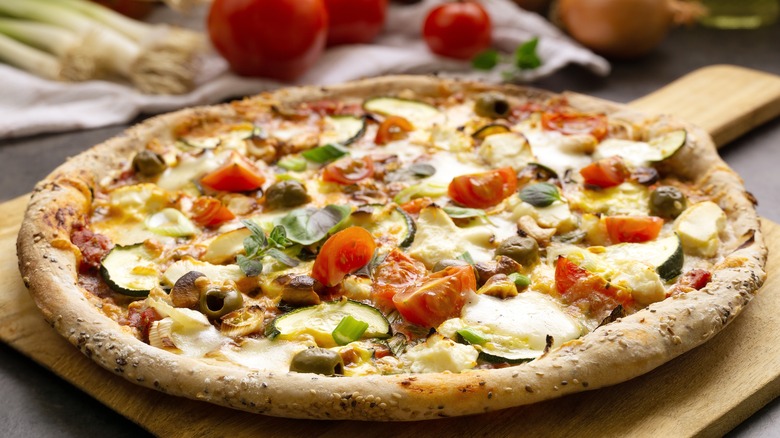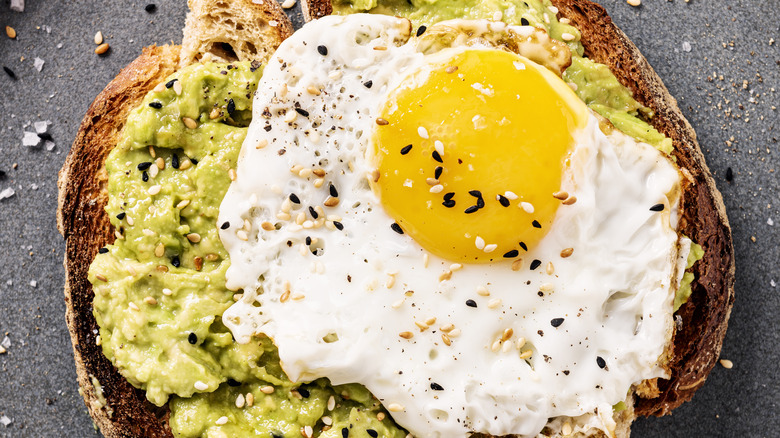16 Creative Ways To Use Sesame Seeds
Many types of edible seeds are tasty, from chia to pumpkin, but we think it's high time for sesame seeds to have their moment — and not just in everything bagel seasoning. There are plenty of deliciously creative ways to use sesame seeds, from sprinkling them as a crunchy garnish to making them into a dessert. We consulted with a few experts to help us come up with the best ideas.
Ranveer Brar is the celebrity chef behind Kashkan Restaurants, and he brings a wealth of knowledge on developing recipes using flavorful ingredients such as sesame seeds. Jessica Randhawa is the head chef, recipe creator, photographer, and writer over at The Forked Spoon, presenting approachable and family-friendly recipes, many of which include sesame seeds. Jessie-Sierra Ross is the food and lifestyle blogger who runs Straight to the Hips, Baby, as well as a frequent food-segment guest on New England TV shows. Juan Bochenski is the executive chef at Ovide, a destination restaurant at Hotel Effie Sandestin, sited on Florida's Emerald Coast.
It helps to note that both black and white sesame seeds can be used in myriad recipes. Both varieties will work for most of these tips, but we'll let you know when one type is best. These interesting concepts will help you finish your pack of sesame seeds in record time.
1. Use them to coat meat or fish
Jazz up your protein dish with sesame seeds, which you can scatter on top as a garnish or mix in as a seasoning. "This adds a nutty flavor and crispy texture to proteins like fish or chicken," says Ranveer Brar. Before you bake or pan-fry the protein, Brar advises coating it in a mix of white and black sesame seeds to develop an attractive, crunchy crust.
Use this method to give beef stir-fry a sesame seed coating — but this enhancement works with many types of protein. Juan Bochenski adds them to Ovide's pork rib appetizer as a garnish. "It not only enhances the presentation, but also adds a bit of flavor to the dish," he shares.
Jessica Randhawa likes to press a mixture of white and black sesame seeds onto the surface of salmon or chicken before pan-searing or baking. "This method is a simple way to elevate an ordinary meal into something special with minimal effort," she says. No matter which protein you use, the seeds add visual appeal, a contrast in textures, and signature nuttiness.
2. Infuse oil with sesame seeds
A sesame-infused oil can impart subtle earthy flavors into many foods, like salads, noodles, or marinades. Don't confuse sesame-infused oils with sesame oil, which is made entirely with cold-pressed sesame seeds. To make the infused version, Ranveer Brar says to lightly toast sesame seeds and put them into a warm, neutral oil, such as canola, grapeseed, or avocado.
After adding the sesame seeds, let the oil cool down, and "then strain the liquid to obtain a flavored oil that is free from any solids," Brar suggests. Or, using a different method, blend the mixture and then strain it with a cloth-lined sieve to let the oil through. To maintain maximum freshness, store the sesame-infused oil in an airtight container. "To avoid destroying its taste ... consume within a week of infusion," says Brar. This enhanced oil can quickly make your culinary adventures flavorful and distinct. Try it with roasted vegetables like broccoli and bell pepper, or in a chicken stir fry.
3. Enjoy them in a cocktail
Cocktails are delightfully versatile in terms of ingredients, preparation, and appearance. Use sesame seeds in them as a garnish, or to give the drink a light, nutty flavor.
Forget about a common vodka soda — try a wasabi-yuzu vodka oyster shooters recipe when you want a sesame-enhanced drink that's unforgettable. This is beautifully balanced with heat from the wasabi, sweetness from the simple syrup, and savory flavors from the shallot and oysters. It doesn't hurt that this cocktail comes topped with a snack. Sprinkle the sesame seeds — both black and white, if you have them on hand — onto the shucked oyster.
Alternatively, garnish the rim of a cocktail with sesame seeds, or coat cucumber slices with them for an edible glass decoration. The flavor of sesame works well with vodka, rum, whiskey, or ginger liqueur. For sweet additions, honey and flavored syrups work nicely to complement the seeds' light, nutty taste.
4. Integrate sesame seeds into crackers
Snacking on crackers with dip is one of life's simple pleasures. Bake a batch of gluten-free pumpkin seed crackers with pumpkin hummus using a variety of ingredients, including sesame seeds.
However, it's important to use fresh seeds for recipes like this, according to Jessie-Sierra Ross. "Sesame seeds do have a limited shelf life," she says. "Sesame seeds are filled with rich oils that can turn rancid, just like other pressed oils. So, even though it's tempting to buy sesame seeds in large batches, it's best to stock smaller portions in the pantry."
These crackers use ¼ cup of sesame seeds, which is perfect if you have a small amount left that you want to use in time for prime freshness. "My trick to make sure my sesame seeds are still good is to give them a quick sniff. If they smell off or a bit sour, it's time to buy a fresh batch," says Ross. Apply the same technique to other seeds, such as sunflower or pumpkin seeds.
5. Mix them into salad dressings
When venturing to the salad dressing aisle of the supermarket, you've likely noticed the shelves upon shelves of options to select from. But there are even more possibilities if you create dressings yourself. Sesame seeds are a tasty component to add to this condiment, but they benefit from heating before incorporating them. "If you roast the sesame or benne seeds first, the heat releases the oils, bringing the natural aromas and flavors to the forefront of the taste buds," says Juan Bochenski.
The seeds work well with many greens, but especially in Asian-inspired salads. "I grind the sesame seeds into a fine powder using a mortar and pestle or a small food processor, then blend them with ingredients like soy sauce, vinegar, and honey," says Jessica Randhawa. "This sesame seed dressing adds a rich, creamy texture and a subtle, earthy flavor to salads, making them more intriguing and flavorful."
The inclusion of sesame seeds also works in a vinaigrette along with parsley, rosemary, black pepper, and onion powder. Bored of salads? Use a sesame dressing as a marinade for chicken, to top steamed vegetables, or to coat coleslaw.
6. Add them to baked goods
Seeds of all sorts are used in baked goods, and sesame seeds are an excellent choice. We love the distinct nuttiness they bring to amp up sweet treats like sesame seed chocolate chip cookies. This simple enhancement provides these classic cookies with a nut-free earthy profile.
Rather than mixing them into the batter, use sesame seeds as a topping for the cookies, providing both texture and taste. Unlike flaxseed — which can be difficult to chew — or larger pumpkin seeds, sesame seeds are petite and softer, but they have a pleasantly crunchy exterior.
Sesame seeds are the key ingredient in biscotti regina, a Sicilian cookie. However, you can mix sesame seeds into varied baked goods to quickly transform everyday recipes into exceptional desserts. This tiny addition can revitalize your most basic baked treats. Sprinkle black and white sesame seeds atop your favorite loaf cake, or mix them directly into the batter.
7. Turn sesame seeds into a spread
Sesame seeds can be used to make incredible spreads — this is one of the unexpected ways to use tahini, which is simply sesame seed paste. It's also not difficult to prepare sesame seed butter, according to Ranveer Brar. Blend toasted sesame seeds, a drizzle of honey, and a pinch of salt until smooth. "This butter is perfect for spreading on toast, pairing with fruits, and also as a dip for vegetables," says Brar. Keep this refrigerated in an airtight container, and stir before using it if separation occurs.
For a spread with a deeper taste, try a black sesame paste, which can impart earthier flavors. According to Juan Bochenski, "black sesame seeds ... have a bit more of a nutty flavor than the white seeds."
Halva is made with tahini and sugar syrup. It comes in different flavors and inclusions, like pistachio or chocolate, and can be eaten alone or spread onto bread. This Mediterranean specialty can be found at international markets or bought online.
8. Add them to pesto
For anyone who prefers not to eat pine nuts, use sesame seeds as the nutty-flavored component in pesto. It's certainly an unexpected choice, but sesame seeds can be one of the best pine nut substitutes for pesto, adding dimension to this Italian condiment in a fresh way without totally changing the flavor into something unrecognizable. The simple effect provided by sesame seeds makes this pesto variation an excellent accompaniment for pasta, or a perfect pairing for protein-rich dishes like oven-baked pesto salmon with cherry tomatoes.
The preparation of this pesto will be similar to a standard recipe, mixing everything together in a blender until all ingredients are integrated. It's up to you how smooth or chunky you like this green condiment. Sesame seeds also work well for a non-basil variation like cilantro pesto, or switch things up by using Thai basil. Add this flavorful pesto to your favorite lasagna, slather it on your next sandwich, or coat veggies with it.
9. Try sesame seeds in a spice mix
There are plenty of spice mixes that typically include sesame seeds, from za'atar blend to everything bagel seasoning. But if you're searching for more creative ways to use sesame seeds, we have some spicy ideas for you. Shichimi togarashi is a Japanese blend of spices, often including toasted sesame seeds, orange zest, white poppy seeds, paprika, peppercorns, ginger, and toasted seaweed. Add this mix to soups, stir-fry recipes, beef, poultry, tofu, or even as a cocktail rim for a spicy, citrusy, and nutty enhancement.
Ranveer Brar recommends creating a spice blend of cumin, coriander, chili flakes, and sesame seeds to be sprinkled on vegetables and meats before roasting them. "Ensure that you lightly toast the spices and seeds before you grind them, so that their flavors become stronger," says Brar. Toasting your spices only takes a minute or two, but it allows you to extract their natural flavors to give them a boost of flavor and aroma. However, since sesame seeds are small, be careful not to burn them as they cook quickly.
10. Blend them to use as a flour or thickener
Gluten-free alternative flours can be found in almost every grocery store, and they're made from diverse ingredients ranging from almonds to oats to coconuts. However, sesame-seed flour is not so common — but according to Jessie-Sierra Ross, it isn't difficult to make this yourself.
"Simply toast your sesame seeds, cool, and then add to a coffee grinder. Pulse until you get a golden gluten-free flour," Ross explains. "When mixed with almond flour, salt, and a little bit of melted butter, you get an almost sesame-cookie-like taste and texture after baking. It's amazing as a cheesecake crust or tart shell."
Juan Bochenski shares an alternative method for making and utilizing sesame seed flour. "Use a food processor to pulverize the toasted seeds to a powder-like texture, and it acts as a thickening agent, creating a smooth texture [for a] dressing or dip," says Bochenski. This is just another example of how these wee seeds are so adaptable.
11. Include sesame seeds in homemade granola
Once you understand the core steps of making granola, you can get resourceful with the flavors and add-ins. "One creative use for sesame seeds is to incorporate them into homemade granola. They add a delightful crunch and a nutty flavor that pairs beautifully with oats, nuts, and dried fruits," says Jessica Randhawa. Sesame-infused granola also works well with coconut, maple syrup, or sunflower seeds.
"I like to toast the sesame seeds lightly before mixing them into the granola batter to enhance their flavor. This not only boosts the nutritional profile of your granola with healthy fats and minerals, but also gives it a unique texture," Randhawa shares. Follow a homemade crunchy granola recipe and add both black and white sesame seeds. Eat the granola by itself, enjoy it with yogurt, or crumble it into a bowl and add milk to eat it like cereal. For a savory version of sesame-seed granola, you can add pepper, soy sauce, fennel, or crushed red pepper, and add this to salads or soups.
12. Sprinkle them onto vegetables
Vegetables and sesame seeds are an underrated duo. The seeds heighten veggies by imparting a nutty taste and adding texture to the dish, especially with Asian-inspired specialties like stir fry recipes. However, sesame seeds can be added to many other veggie dishes to provide a subtle lift in flavor. For example, a sprinkle of sesame seeds is the simplest way to elevate green beans. The crisp string beans complement the subtle crunch of the sesame seeds.
Roast carrots with honey, and sprinkle on the sesame seeds when you're plating the dish. Try them with blanched spinach and sesame oil, or in a blend of kale and broccoli to create a vibrant side dish. Since they're so small and burn quickly, you should add the seeds at the end of cooking unless your recipe says otherwise. The sesame seeds can transform a veggie that you've had countless times into a refreshed version of itself.
13. Use them when making sushi
Make sushi for a fun date night or an elegant family dinner. Start with a California roll recipe that includes sesame seeds — and try toasting them before sprinkling them onto the rice to enhance the taste.
"Toasting sesame seeds can really bring out the rich and complex nutty flavors of this unassuming little ingredient," advises Jessie-Sierra Ross. "Toasting on low heat in a dry skillet for five to seven minutes helps to release the fragrant, naturally occurring oils in the sesame seeds." The seeds won't be visible within the sushi, but they create a satisfying crunch that works with the softness of the California roll's rice and creamy avocado.
For another option, prepare a spicy crab salad sushi recipe with sriracha, if you want something with a kick. And according to Juan Bochenski, the way how you should be seasoning poke — another raw-fish dish — is with both black and white sesame seeds, which gives this Hawaiian delicacy lots of flavor, texture, and a beautiful presentation.
14. Make sesame brittle
"For a fun and tasty snack, I like to make sesame seed brittle," says Jessica Randhawa. Most often, you'll see this treat made with white sesame seeds, but you could use black seeds or a mixture of both. We think it's mouthwatering enough to gnaw on by itself, but you could always break it up to use as a garnish on yogurt, ice cream, mousse, or cake.
Sesame seed brittle is also a favored snack for Ranveer Brar. "Mix caramelized sugar with toasted sesame seeds and spread thinly on a baking sheet," Brar suggests. "Once cooled completely, break into pieces for eating. Sprinkle a small amount of sea salt over the brittle to give it an extra burst of taste."
While this is a perfect recipe for a sweet and slightly salty snack or garnish, Randhawa warns that you need to be careful when preparing it to prevent the sesame seeds from being scorched. "The key here is to watch the sugar closely as it caramelizes to prevent burning," she adds.
15. Give pizza crust more crunch
If you like cornmeal on pizza crust, you might want to try this out. Add sesame seeds to pizza crust for extra crunch, and you can apply them to the crust's bottom or edges. Adding them to both surfaces not only adds visual allure but eases the cooking process and provides a beneficial taste.
As you're spreading the dough out onto the baking sheet, lift one side at a time to sprinkle the sesame seeds underneath. Gently press the dough down to ensure that the seeds stick. Since this mimics the role of cornmeal on pizza crust — helping prevent the dough from sticking to cooking surfaces — add seeds liberally to the bottom for the full effect.
To add sesame seeds to the top portion of the crust, simply sprinkle them onto the dough and lightly press them in. You can add as much or as little as you want. Both white and black sesame seeds will work for this, though at first glance, loads of black seeds on the crust's bottom might make it appear burnt. However, this adds a nutty flavor and fragrance, and you can still top the pizza with your preferred ingredients.
16. Add sesame seeds to eggs
You've likely seen many trendy ways to make eggs, like adding pesto or chili crisp. Well, the next addition to your list should be eggs topped with sesame seeds.
Sesame seeds are the easy addition to give your fried eggs some crunch. Pour oil into a pan and then spread the seeds into it. Crack an egg into a bowl and carefully pour it into the sesame seeds and oil to cook for a couple of minutes. You don't want to cook this for too long, or you'll risk burning the seeds. Once cooked, top the fried egg with additional sesame seeds for extra crunch. Eat this on top of avocado toast, or with labneh and harissa.
You can also fry your egg as usual without this addition, and then top it with a pinch of both black and white sesame seeds. And if fried eggs aren't your thing, there are plenty of other methods to try. Make creamy deviled eggs with hummus instead of mayo, and then top them with sesame seeds for a non-dairy option. These are fantastic for a novel take on a familiar appetizer to bring to a luncheon.
